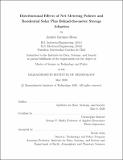| dc.contributor.advisor | Christopher Knittel. | en_US |
| dc.contributor.author | Inzunza Besio, Andrés. | en_US |
| dc.contributor.other | Massachusetts Institute of Technology. Institute for Data, Systems, and Society. | en_US |
| dc.contributor.other | Technology and Policy Program. | en_US |
| dc.date.accessioned | 2020-09-03T18:47:47Z | |
| dc.date.available | 2020-09-03T18:47:47Z | |
| dc.date.copyright | 2020 | en_US |
| dc.date.issued | 2020 | en_US |
| dc.identifier.uri | https://hdl.handle.net/1721.1/127171 | |
| dc.description | Thesis: S.M. in Technology and Policy, Massachusetts Institute of Technology, School of Engineering, Institute for Data, Systems, and Society, May, 2020 | en_US |
| dc.description | Cataloged from the official PDF of thesis. | en_US |
| dc.description | Includes bibliographical references (pages 66-70). | en_US |
| dc.description.abstract | Several authors argue that net metering schemes (NEM), typically implemented to incentivize investment on distributed energy resources (DER), could be regressive, given that DER adopters in the U.S. are wealthier on average than non-adopters and due to the possibility that DER owners shift certain costs onto passive customers. By using a dataset containing close to 100,000 customers' half-hourly load data and income quintiles from Chicago, IL, we simulate the operation of residential solar and behind-the-meter battery systems under 20%, 45% and 70% adoption levels and calculate both resulting bills for every client in the dataset, as well as cost shifts arising from the combination of NEM and the allocation of network and policy costs (i.e., residual costs) through volumetric charges (i.e., in $/kWh). Additionally, we consider different tariff designs. Results show that the combination of NEM schemes and recovery of residual costs through volumetric charges may cause important cost shifting effects from DER adopters onto non-adopters, rising equity and fairness concerns. Firstly, under NEM schemes, we calculate that adopter customers may, on average, obtain bill reductions of 71% when installing solar or solar plus storage, whereas non-adopters can see their bills increased 18% in high DER penetration scenarios (i.e., 45% penetration). Moreover, under the same NEM schemes, 45% adoption and considering solar plus storage adoption alone, we calculate that customers from the two lowest income quintiles may suffer bill increases in the 16-19% range on average, while removing NEM schemes reduces these increases to the 11-12% range. | en_US |
| dc.description.statementofresponsibility | by Andrés Inzunza Besio. | en_US |
| dc.format.extent | 78 pages | en_US |
| dc.language.iso | eng | en_US |
| dc.publisher | Massachusetts Institute of Technology | en_US |
| dc.rights | MIT theses may be protected by copyright. Please reuse MIT thesis content according to the MIT Libraries Permissions Policy, which is available through the URL provided. | en_US |
| dc.rights.uri | http://dspace.mit.edu/handle/1721.1/7582 | en_US |
| dc.subject | Institute for Data, Systems, and Society. | en_US |
| dc.subject | Technology and Policy Program. | en_US |
| dc.title | Distributional effects of net metering policies and residential solar plus behind-the-meter storage adoption | en_US |
| dc.type | Thesis | en_US |
| dc.description.degree | S.M. in Technology and Policy | en_US |
| dc.contributor.department | Massachusetts Institute of Technology. Institute for Data, Systems, and Society | en_US |
| dc.contributor.department | Massachusetts Institute of Technology. Engineering Systems Division | |
| dc.contributor.department | Technology and Policy Program | en_US |
| dc.identifier.oclc | 1191626203 | en_US |
| dc.description.collection | S.M.inTechnologyandPolicy Massachusetts Institute of Technology, School of Engineering, Institute for Data, Systems, and Society | en_US |
| dspace.imported | 2020-09-03T18:47:47Z | en_US |
| mit.thesis.degree | Master | en_US |
| mit.thesis.department | ESD | en_US |
| mit.thesis.department | IDSS | en_US |
